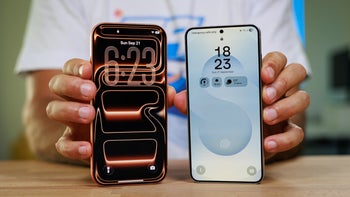Samsung just sabotaged the Galaxy Z Fold 7. What now?
No silicon-carbon, no buy.
This article may contain personal views and opinion from the author.

We are just days away from the Galaxy Z Fold 7's official announcement on July 9, but the upcoming foldable phone's fate has already been sealed for me: it's a disaster in the making.
I'm going to cut to the chase here and not waste any more time with world building. It's the purported battery size that concerns and infuriates me at the same time. The rumor mill is telling us Samsung is not eyeing a battery increase for its ultra-thin new foldable phone, meaning it will mirror the Galaxy Z Fold 6 and come with a 4,400 mAh battery, or worse, even a smaller one.
And looking at the fuller picture, many might jump in to defend Samsung with the notion that, yes, the Galaxy Z Fold 7 is significantly slimmer than any of the company's prior foldables, so there was just no physical space left for a larger battery, you see. That would have been accurate and understandable years ago, when Li-ion batteries were more constrained by space.
However, it's mid-2025, and this problem has already been solved, seemingly by everyone but Samsung.
Why isn't Samsung going the silicon-carbon way?
There's an easy solution to the battery issue on foldable phones that almost all current devices have already solved, and it's called silicon-carbon batteries.
These are denser than the standard lithium-ion batteries and conserve more energy in the same-sized battery cell, allowing phone vendors to do crazy things like putting a 5,600 mAh battery inside an ultraslim 8.93 mm foldable phone. Those are the exact specs behind Oppo's exceptional Find N5 foldable, which feels like a much more complete foldable flagship.
The Vivo X Fold 3 Pro I've been using for the past few months? A bit thicker at 11.2 mm, but still packing a large 5,700 mAh battery, and that's a phone that's more than a year old.
Actually, come to think of it, most of Samsung's rivals are already actively using silicon-carbon batteries on both foldables and traditional flagship phones, delivering wonderful battery endurance in bodies that are often slimmer than their Samsung counterparts.
Samsung is falling behind and is no longer willing to give us the bleeding-edge tech
But what could be the real reason Samsung simply doesn't want to give people what they want and match the exploits of all China-based foldable phone makers out there? At this point, it appears that the real reason could be the higher costs of silicon-carbon batteries and Samsung's unwillingness to soak them up or past them over to consumers. The South Korea-based giant is either unwilling to pay the licensing fees for the patented tech, and that is hurting the appeal of its otherwise decent phones.
We've been stuck with 5,000 mAh batteries on the flagship Galaxy S Ultra lineup for half a decade already, and the competition has not only caught up, but is already lapping Samsung. Even Apple, which is usually so averse to hardware innovation, is dangerously close to topping Samsung's batteries not only in overall endurance, but in terms of capacity, too.
Could Samsung be betting on a home-grown solution? The company unveiled a solid-state battery back in 2024, which aims to give us super-stable batteries that are way less prone to "accidents", but they only max out at 200Wh/l, which isn't very inspiring when you compare a lithium-ion battery's range between 250 and 700 Wh/l. This means Samsung's solid-state batteries are a long way from being actual alternatives to conventional lithium-ion or silicon-carbon batteries; SSBs are also seemingly way, way more expensive at the moment, so pretty far away from mass production and the prime time.
It's time for Samsung to move past the Galaxy Note 7 disaster
Another obvious reason for Samsung's apparent unwillingness to give us good batteries in phones could be the now ancient Galaxy Note 7. Back in 2016, an ill-fated manufacturing defect with the batteries of the S Pen phone caused many units to overheat and catch on fire, and the reason for that was the specific curved shape of the device, which required an odd-shaped battery cell. This led to the unfortunate discontinuation of the Galaxy Note 7.
Samsung has apologized one too many times about this mishap over the years, and we've already accepted the apology. It even introduced an industry-leading 8-point battery safe check back in the day, which is still relevant to this day.
However, it's 2025 now, and it's time for the company to move on and once again start experimenting with batteries. Safely, of course.
The Galaxy Z Fold 7 had so much potential to finally help Samsung retake the foldable throne. Instead, it proves the company is trailing behind its more exotic rivals
But let's get back to the Galaxy Z Fold 7, a device that is set to do so many things right and yet skimp on one of the more crucial ones yet again, potentially leaving us with a foldable phone very close to greatness, but not quite there just yet.
Samsung kept an ear close to the ground and will finally give us an actually good and thin design, get rid of the useless inner selfie camera, and will finally employ an actually useful cover screen. Pair that with the flagship-grade Snapdragon 8 Elite chip and the decent One UI interface, and you get a strong rival for the title of "best foldable in the US". We'll see how the Pixel 10 Pro Fold will fare.
However, on the global stage, there are poised to be much better options from a hardware perspective. Devices like the Oppo Find N5, Honor Magic V5, and the Vivo X Fold 5 are already quickly stepping up to eat Samsung's lunch.
Follow us on Google News





![New T-Mobile CEO has everyone on the edge of their seats with new teaser [UPDATED]](https://m-cdn.phonearena.com/images/article/175840-wide-two_350/New-T-Mobile-CEO-has-everyone-on-the-edge-of-their-seats-with-new-teaser-UPDATED.webp)







Things that are NOT allowed:
To help keep our community safe and free from spam, we apply temporary limits to newly created accounts: